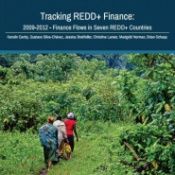REDDX: Keeping Track Of Forest Carbon Finance In 2015
The coming year will be a pivotal one for climate finance, and especially for forests, as more than $7 billion is set to cumulatively flow to forest-protection efforts aimed at Reducing Emissions from Deforestation and Degradation (REDD+) before the year is over. Here’s what we know about past flows in Brazil, Colombia, Ecuador, Ghana, Liberia, Tanzania and Vietnam.

8 January 2015 | The Lima Climate Talks last month yielded the Lima Call for Climate Action, which includes both a negotiating text that will be the basis for the start of negotiations in 2015 and general rules for countries to develop their Intended Nationally-Determined Contributions (INDCs) to the climate effort. With deforestation accounting for more than 15% of all greenhouse gas emissions, many countries will undoubtedly seek to incorporate REDD+ (Reduce Emissions from Deforestation and Degradation and other land use activities (REDD+) into their INDCs, meaning we now have two separate REDD+ tracks to consider.
That’s because INDCs don’t kick in until 2020, but REDD+ is already being deployed today through the private sector and various donor agencies. That means countries will need to figure out exactly how REDD+ is financed in the 2015-2020 period and how it will be integrated into INDCs after 2020. For that to happen, we must all be able to see where REDD+ finance comes from, where it goes, and what it achieves activities that have, until now, been difficult at best.
REDDX
In 2011, Forest Trends launched the REDD+ eXpenditures Tracking Initiative (REDDX) to provide greater transparency around REDD+ financial flows. Despite over US$7.3 billion pledged to support REDD+ Readiness by 2015, information has remained limited on how much of this finance has actually flowed to implementing REDD+ on the ground. In partnership with national government and civil society organizations, REDDX currently operates in fourteen countries collectively representing around 1.1 billion hectares of forest, or about 72% of the global tropical forest cover.
For a comprehensive overview of the Lima COP, see “Countries Know They Have to be Bold and Ambitious Next Year: Lima Negotiations Set That in Motion“.
For a detailed understanding of the new bottom-up approach to combatting climate change, see “INDCs, REDD+, And The Alphabet Soup of COP 20“.
We just released our first REDDX report, “Tracking REDD+ Finance“, which focuses on the years 2009-2012, covering the major developments of the Fast Start Finance period, in the initial seven REDDX pilot countries: Brazil, Colombia, Ecuador, Ghana, Liberia, Tanzania and Vietnam. The consolidation of the major trends and findings in each of the seven REDDX pilot countries presents a microcosm of the global picture of REDD+ finance. Key findings include:
- Increasing commitments to REDD+: Between 2009 and the end of 2012, total REDD+ finance commitments increased steadily to US$1.2 billion.
- Large gap between commitments and disbursements for REDD+: In the seven pilot REDDX countries, large commitments by donors for REDD+ were often followed by long delays before initial disbursement of funds. Of the US$1.2 billion tracked by REDDX in seven countries, less than a third (US$378.3 million) had been disbursed by the end of 2012.
- Multilateral sources of funds are beginning to overshadow the bilateral donors and private foundations that had supplied early REDD+ finance: Approximately 78% of all REDD+ finance was committed by bilateral government donors, with the governments of Norway and Germany responsible for over 91% of these commitments.
- The role of domestic contributions by REDD+ countries increasingly recognized: The extent to which national governments are themselves supporting activities for REDD+ has not been comprehensively quantified, yet domestic financing is increasingly being recognized as an important piece of the REDD+ finance landscape.
- Low level of private sector financing: Our findings show that the private sector is still not making large-scale REDD+ investments. Data from the voluntary carbon market indicates that the private sector spent US $379 million in carbon offsets in 54 countries during 2013 while the seven REDDX countries only tracked around US $1.2 million. REDDX tracks funding and activities associated with national level REDD+ development. For private sector projects that are not linked with jurisdictional REDD+ programs, please refer to Ecosystem Marketplace state of the voluntary carbon market report 2014.
This report and other information can be found on the REDDX website at: http://reddx.forest-trends.org/
Please see our Reprint Guidelines for details on republishing our articles.

